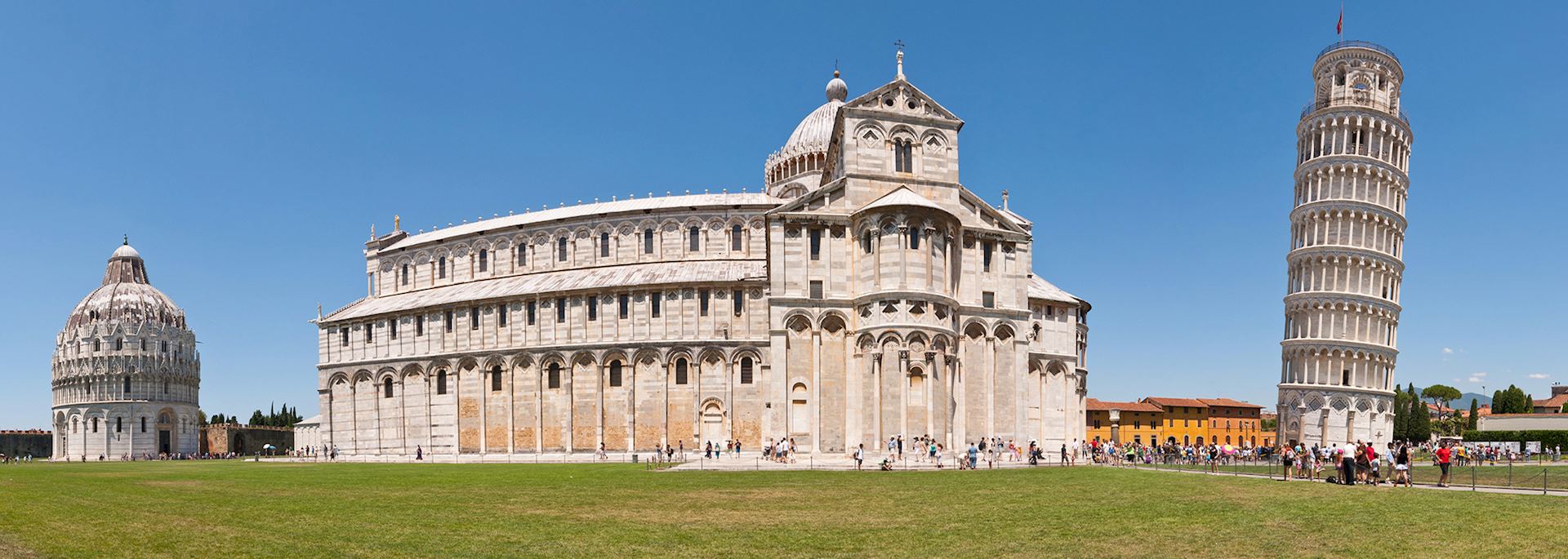Thanks to its infamous leaning tower, Pisa is known the world over. However, the tower is just one of a collection of magnificent buildings in the Campo dei Miracoli or Field of Miracles, that date to the city's heyday as a major maritime power between the 11th and 13th centuries. The arresting walled square is home to the cathedral, baptistry, cemetery and bell tower, which together form one of the world’s greatest collections of Romanesque architecture. Beyond the glorious square, the city has a youthful vibrancy thanks to its elite university, where Pisa’s most famous son, Galileo, was once a professor.
Italy specialist CarolineTo get the most out of Pisa, go with a guide. Most visitors only climb the Leaning Tower, but don’t neglect its adjoining cathedral and baptistery. The baptistery has its own secret — its spectacular acoustics.
Things to see and do in Pisa
The Leaning Tower
Construction of Pisa’s iconic bell tower began in 1173 and encountered issues with subsidence right from the start. Over the next 200 years a number of different architects attempted to correct the lean, eventually making the height of the tiers shorter on one side to even things out. By 1990 however, the tower was tilting 4.5 m off the vertical and drastic steps were needed to shore it up. With the aid of steel braces and the removal of tons of earth, the lean was corrected by about 44 cm (17 in) and the tower reopened to the public in 2001.
Duomo
Construction on Pisa's lavish medieval cathedral began in 1064 and, when completed in 1118, it was the largest in Europe. The marble façade features a series of tall blind arches topped by four tiers of open galleries with delicate columns. Three elaborate 16th-century bronze doors mark the entrance and lead to a soaring interior with a gilded coffered ceiling. The interior of the cathedral was largely destroyed in a fire in 1595, but the intricate 14th-century pulpit carved from Carrara marble by Giovanni Pisano survived, as did the impressive mosaic work in the apse. Other artworks in the cathedral date from the Renaissance period.
Baptistry
Pisa's ornate, round baptistry is the largest in Italy and is topped by a double dome adorned with a bronze of Saint John the Baptist. The building clearly demonstrates the changes in architectural styles over the period of its construction with rounded Romanesque arches on the lower levels and pointed Gothic arches above. Inside, the marble pulpit was sculpted by Nicola Pisano, but the most remarkable feature is the perfect acoustics created by the double dome. It's worth climbing to the Upper Gallery on the half hour to hear the custodian demonstrating the resonating sound effects.
who's been there
-
01993 838 92501993 838 960
- Make an enquiry
Places near Pisa
- Forte dei Marmi 21 miles away
- Porto Venere 37 miles away
- San Gimignano 37 miles away
- Florence 43 miles away
- Cinque Terre 43 miles away
- Siena 55 miles away
- Modena 69 miles away
- Bologna 72 miles away
- Portofino and Santa Margherita 72 miles away
- Parma 75 miles away
- Genoa 87 miles away
- Ravenna 102 miles away
- Perugia 109 miles away
- Orvieto 111 miles away
- Umbria 119 miles away
- Assisi 121 miles away
- Sirmione 122 miles away
- Verona 123 miles away
- Lake Garda 131 miles away
- Gardone Riviera 132 miles away
- Barbaresco 135 miles away
- Milan 135 miles away
- Alba 136 miles away
- Barolo 137 miles away
- Venice 153 miles away
- Como 158 miles away
- Blevio 160 miles away
- Piedmont 160 miles away
- Torno 161 miles away
- Laglio 162 miles away
- Turin 164 miles away
- Lezzeno 165 miles away
- Rome 165 miles away
- Bellagio 167 miles away
- Tremezzo 168 miles away
- Lake Como 170 miles away
- Madonna di Campiglio 175 miles away
- Stresa 176 miles away
- Verbania 178 miles away
- Lake Maggiore 179 miles away
- Costa Smeralda 186 miles away
- Dolomites 199 miles away
- Alta Badia 212 miles away
- Sardinia 260 miles away
- Ischia 276 miles away
- Naples 281 miles away
- Herculaneum 286 miles away
- Pompeii 294 miles away
- Capri 295 miles away
- Sorrento 296 miles away
Photos of Pisa
Our expert guides to exploring Pisa
Written by our specialists from their own experiences of visiting Pisa, these guides will help you make the most of your time there. We share both our practical recommendations and the best ways to appreciate Pisa at its best.
-
Food highlights of Italy ![Italian market produce]()
Food highlights of Italy
Food highlights of Italy
Italy specialist Caroline talks about her love of Italian food in this guide, focusing on the more renowned culinary cities and regions. She also talks about her experiences of creating pasta, catching fresh fish for dinner in Sorrento, wine tasting in Tuscany's Chianti region and where to eat like a local.
Read this guide












